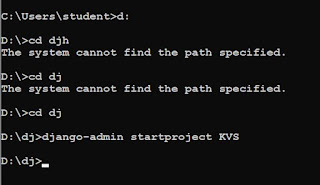create table student
(student_id int(5) primary key,
name char(20),
class char(3),
DOB date,
gender char(1),
city char(10),
marks int(3)
);
Query OK, 0 rows affected, 2 warnings (1.42 sec)
desc student;
+------------+----------+------+-----+---------+-------+
| Field | Type | Null | Key | Default | Extra |
+------------+----------+------+-----+---------+-------+
| student_id | int(5) | NO | PRI | NULL | |
| name | char(20) | YES | | NULL | |
| class | char(3) | YES | | NULL | |
| DOB | date | YES | | NULL | |
| gender | char(1) | YES | | NULL | |
| city | char(10) | YES | | NULL | |
| marks | int(3) | YES | | NULL | |
+------------+----------+------+-----+---------+-------+
7 rows in set (0.02 sec)
insert into student values(12301,"abhinav","X","1995/06/06","M","Agra",551);
insert into student values(12302,"abhineet","XII","1993/05/07","M","Mumbai",462);
insert into student values(12303,"aniket","XI","1994/05/06","F","Delhi",400);
insert into student values(12304,"apar","XII","1995/08/08","F","Mumbai",450);
insert into student values(12305,"brij","XII","1995/10/08","M","Delhi",369);
insert into student values(12306,"bhuvnesh","XI","1994/12/12","F","Dubai",250);
insert into student values(12307,"devesh","X","1995/12/08","F","Moscow",377);
insert into student values(12308,"dhruva","X","1995/06/12","M","Moscow",489);
select * from student;
+-------------+----------+-------+------------+--------+--------+-------+
| student_id | name | class | DOB | gender | city | marks |
+-------------+----------+-------+------------+--------+--------+-------+
| 12301 | abhinav | X | 1995-06-06 | M | Agra | 551 |
| 12302 | abhineet | XII | 1993-05-07 | M | Mumbai | 462 |
| 12303 | aniket | XI | 1994-05-06 | F | Delhi | 400 |
| 12304 | apar | XII | 1995-08-08 | F | Mumbai | 450 |
| 12305 | brij | XII | 1995-10-08 | M | Delhi | 369 |
| 12306 | bhuvnesh | XI | 1994-12-12 | F | Dubai | 250 |
| 12307 | devesh | X | 1995-12-08 | F | Moscow | 377 |
| 12308 | dhruva | X | 1995-06-12 | M | Moscow | 489 |
+------------+----------+-------+------------+--------+--------+-------+
8 rows in set (0.00 sec)
select student_id,marks from student order by marks;
+------------+-------+
| student_id | marks |
+------------+-------+
| 12306 | 250 |
| 12305 | 369 |
| 12307 | 377 |
| 12303 | 400 |
| 12304 | 450 |
| 12302 | 462 |
| 12308 | 489 |
| 12301 | 551 |
+------------+-------+
8 rows in set (0.00 sec)
mysql> select student_id,marks from student order by marks desc;
+------------+-------+
| student_id | marks |
+------------+-------+
| 12301 | 551 |
| 12308 | 489 |
| 12302 | 462 |
| 12304 | 450 |
| 12303 | 400 |
| 12307 | 377 |
| 12305 | 369 |
| 12306 | 250 |
+------------+-------+
8 rows in set (0.00 sec)












